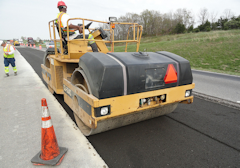
The Landford crew used a Wirtgen paver that scraped up asphalt, reconstituted it and paved it on the spot. Photo credit: VDOT.
by James A. Bacon
America’s Interstate highways are reaching the end of their design lives. Reconstructing them could cost Virginia billions of dollars and cause massive disruptions to traffic while they are under repair. Fortunately, the Virginia Department of Transportation has developed a system for cutting the costs and slashing construction times that could make the cost affordable and the reconstruction process tolerable.
In a first-in-the-nation demonstration project, VDOT repaired 3.7 miles of Interstate 81 near Staunton last year that could provide the prototype for rebuilding the state’s interstate highway system. Working with contractor Lanford Brothers Company, Inc., of Roanoke, the highway department combined three existing processes — cold in-place recycling, cold central-plant recycling and full in-depth reclamation. The project cost $7.4 million as opposed to an estimated $40 million using traditional techniques.
“Using these pavement recycling methods has the potential to revolutionize how we rehabilitate our aging roads, both in Virginia and nationally,” said Governor Bob McDonnell in a press release. “We expect to continue using these processes, where appropriate, to save money and materials as we rebuild older roads throughout the commonwealth. VDOT next plans to use cold in-place recycling to rebuild a section of U.S. 17 in Isle of Wight County in Hampton Roads during the 2012 paving season.”
Highways consist of three layers: a compacted soil base, a foot of compacted stone aggregate and a foot of hot-mix asphalt. On I-81, the right, southbound lane had received the heaviest pounding and needed the most work. The contractor milled down the upper asphalt layer, stockpiling it on site for reuse. Then it applied a stabilizing agent (cement or lime) to strengthen the aggregate below. The milled asphalt was processed at a nearby mobile plant and applied as a new top layer. For the left southbound lane, which was in better shape, five inches were pulverized in place, mixed with a binding agent, applied back to the roadway and topped off with four inches of traditional hot-mix asphalt. Much of the material work was conducted at ambient, rather than hot, temperatures.
“Savings on the I-81 in-place pavement recycling project go beyond time, money and materials,” said VDOT Commissioner Greg Whirley. “It saved fuel because it reduced the need to transport as much new and old materials. It increased safety for drivers and road workers on the project, because it reduced work-zone congestion. This section of rebuilt pavement also will be stronger from bottom to top, extending its service life and reducing the need for such complex maintenance for many years.”
Using traditional methods, the work would have consumed a year or more non-stop during which much of I-81 traffic would have been diverted to Route 11, where it would have conflicted with local traffic. With the new process, the plan called for work to be confined to eight five-day stretches. In actual practice, only three or four of those segments were needed, says Sandy Myers, public relations manager for the Staunton transportation district.
The project also used a novel traffic-management plan to detour cars onto U.S. 11 away from the construction while large trucks used a lane on I-81 that was not under construction. VDOT alerted motorists to the work several hundred miles from the project via on-road, Web and other communication tools.


